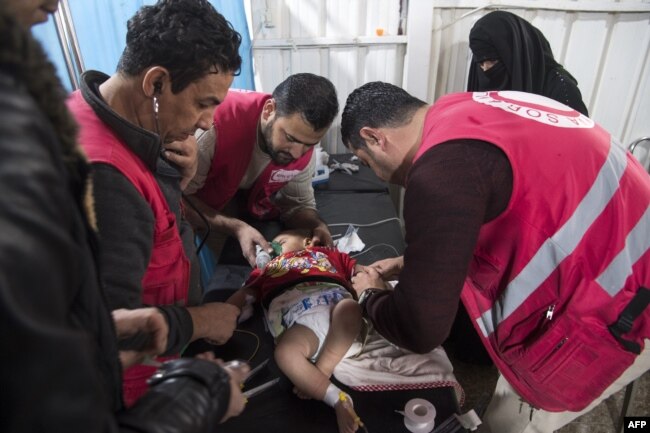More than 23,000 Syrian civilians and foreign nationals have fled eastern Syria this week as the U.S.-backed Syrian Democratic Forces move on the last Islamic State pockets in Deir el-Zour governorate, according to local officials and activists, VOA news reports.
The displaced residents, mostly women and children, have been placed in the Kurdish al-Hol camp in al-Hasakah governorate in Syria’s northeast.
The administrator of the camp, Nabil Hassan, told VOA that many of the women and children in the new wave of displacement this week are foreign nationals and family members of IS.
“Most of the new arrivals are Iraqis and some of them are Syrians. They are mostly wives and children of [IS] thugs,” Hassan told VOA.
An estimated 1,000 foreign nationals from Europe and Central and East Asia have also arrived at the camp since the escalation of clashes in mid-December, according to Hassan.
U.S. President Donald Trump, who has decided to withdraw American troops from Syria following IS’s defeat, predicted Wednesday that all the IS territory would be cleared in the coming days as the U.S.-backed Syrian Democratic Forces (SDF) drew closer to ousting the jihadist group, which still controls tiny pockets of the countryside near Deir el-Zour.
“It should be formally announced sometime, probably next week, that we will have 100 percent of the caliphate,” Trump said during a meeting with representatives of the 79-member U.S.-led coalition fighting against IS.
The SDF, backed by coalition airstrikes, was fighting IS in a 4-square-kilometer area consisting of the Baghouz and As Safafinah villages near the Iraqi border.
SDF officials estimated there were about 3,000 IS jihadists, mostly foreigners, who were determined to fight to the death.
Heavy clashes between the SDF and the IS fighters Thursday left 15 jihadists dead and large numbers of their weapons seized, according to an SDF statement. Coalition jets assisted with 22 airstrikes against IS positions.
SDF commanders said they thought many of the foreign fighters would end up being captured in the coming days, adding to about 1,000 foreign jihadists from over 40 countries currently in the Kurdish detention centers in northeast Syria.
The Kurdish self-administration complained that their detention facilities were already overwhelmed and criticized the relevant countries for not repatriating their nationals.
U.S. officials have echoed the call of their Kurdish partners.
“The United States calls upon other nations to repatriate and prosecute their citizens detained by the SDF and commends the continued efforts of the SDF to return these foreign terrorist fighters to their countries of origin,” U.S. State Department deputy spokesman Robert Palladino said in a statement Monday.
Guantanamo Option
The U.S. State Department said Thursday that the fighters could be transported to the detention center on the U.S. base at Guantanamo Bay, Cuba, if they could not be repatriated.
Last month, the SDF handed over five IS fighters, along with 11 wives and 30 children of IS fighters, from Kazakhstan to Kazakh authorities following months of preparation. Other countries have been less willing to follow suit because of the difficulty of prosecuting suspected IS fighters based on evidence collected from the battlefield.
Local officials fear the new wave of arrested fighters and displaced residents could also spark disease outbreaks, as many new arrivals suffer from illnesses because of a lack of access to medical services in the besieged IS areas.
Masoud Ramo, head of the Kurdish Red Cross, told VOA that many displaced residents arrived at al-Hol camp suffering from malnutrition, lung diseases and contagious viruses. He said many fleeing residents, especially children, die on the way or suffer injuries requiring amputations because of land mines.
“Many of the new arrivals are injured from land mines and need urgent surgeries. Some others need treatment for previous conditions. There is honestly a heavy pressure on us,” Ramo said.
Human shields
Civilians interviewed by VOA at the al-Hol camp said they were able to leave their homes only after the SDF entered their areas. They said IS fighters had prevented them from escaping, using them instead as human shields to prevent airstrikes.
“There are now displaced civilians in areas under IS and Syrian Democratic Forces” control, said Sheikh Abdulbasid Ali, the head of al-Shuaitat tribe, who fled with his family to the al-Hol camp after years of living under IS control.
“We are grateful to the Syrian Democratic Forces for bringing civilians from IS areas to refugee camps,” he told VOA.
The U.N. High Commissioner for Refugees last week reported that more than 35 children and infants had died from hypothermia and malnourishment since December on the journey to or while at the camp.
